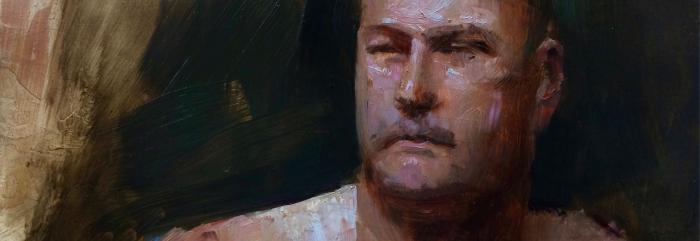Painting and Time
art .....
Next: Code and Data
Prev: Learning Muscular Anatomy
Painting is quite old and hard to fool. –Tad Spurgeon
In Living Craft, Spurgeon calls out time as the first "material" used to make paintings. He speaks of "extra-logical," emotional time, time experienced by the mind of the painter, rather than purely physical time measured by clocks. His remarks frame an invitation to contemplate how one experiences time in the studio and what time means to painters (and, by extension, viewers).
There is no question that paintings take time to make, sometimes a lot of time… from minutes to hundreds or thousands of hours.1 Much contemporary activity seems to be oriented around saving time, but a single painting can take the kind of time jobs take, or marriages, or kids2. To me, this slowness is part of painting's appeal, one of the reasons that it remains relevant today (as an antidote, at least). Becoming a painter has meant, for me, learning how (and why) to spend that kind of time at the easel… on many paintings at once, switching them as drying times and inspiration require, or on just one at a time.
Paintings connect the present moment of painting (or viewing) with various points in the past and future. This moment, this tip of this brush containing this much of this color and this consistency of paint with this precise location on this surface, and this breath, this experience of the image reaching the eye and brain, all relate to:
- [ $-$ (0-8) hours ] the moments just prior to this one; the wet paint just put down, to be blended into, left alone, rubbed out, scraped off.
- [ + (0-8) hours ] the moments about to come, in this session; future marks that will be blended into this one; other manipulations about to come, including removal if the current experiment is judged a failure.
- [ $-$ (days, months, years) ] previous paint layers. Ground, underpainting, impasto… existing layers are like sedimentary rocks whose geology tells the story of what the mind and hand were doing during earlier sessions, recording course corrections, adjustment of values and edges, and the evolution of emotion, content and intent. The strata laid down previously are always in the process of being covered or exposed by the current brush strokes, knife application, scraping, sanding. These layers also show things (generally, but not always, mistakes) that you couldn't see previously, but that suddenly become, sometimes painfully, clear.
- [ + (days, months, years) ] the painting as it slowly dries, and paint layers to come. Thoughts of translucency and opacity, of optical mixing, of glazing and scumbling. Where the painting might go. Anticipation of coming successes and failures.
- [ $-$ (days, months, years) ] past drawings or other studies you made for this painting. Other sketches or paintings you made which led you down your current path.
- [ + years ] future paintings you will (hopefully) make. The evolution of your thinking, themes, urges, longings; mistakes you will no longer make; new territories that will open up, that you can't even see yet.
- [ $-$ (years, decades) ] teachings you've received from teachers and mentors.
- [ + (years, decades) ] paintings to be made by students you taught / may teach or people you've inspired / may inspire.
- [ $-$ (years, centuries) ] paintings made in the past that you've seen / liked / hated. All the Great Masters; others, in your personal pantheon of artists. The first artworks you ever saw, or made.
- [ $-$ millennia ] the earliest paintings made. Cave paintings, paintings from ancient civilization.
- [ $-$ ($10^0$ - $10^2$) years ] the production, storage, transportation and cultural context of the raw materials that find their way into your paintings: panels, stretcher bars, linen, linseed oil, pigment, brush fibers, bugs, hair, etc. I have panels prepared by my grandfather and recovered from his woodpile after he died; a handmade cherry-wood palette I got off Instagram that I cherish; and a few kilos of powdered manganese blue (PB-33) that I stockpiled because nobody is producing the pigment or paint anymore.
- [ $-$ ($10^9$ - $10^{10}$) years ] the history of the substances (atoms/molecules) composing those materials: the annual growth and harvest of flax from fields in Europe; slow reactions involving iron in the earth's crust; the early history of the planet's formation; formation of heavy elements such as cadmium, cobalt, and lead in supernova nucleosynthesis; the creation of lighter elements occurring the early universe after the Big Bang.
- [ + (days, years, centuries) ] the fate of your work on the walls of someone's house / palace / fortress / vault / museum / bomb shelter (that is, if anyone keeps it around). Happenstance viewings in various circumstances by future generations.
- [ + ($10^{??}$ years) ] the atoms from your paintings, after they are burned / rotted / crushed / vaporized /….
Every moment of painting is in dialogue with all these other moments and time scales. This conversation of material and mind is far greater than any one person, but it is available while you work, or look, right now.
:Ὁ βίος βραχύς,
ἡ δὲ τέχνη μακρή,
ὁ δὲ καιρὸς ὀξύς,
ἡ δὲ πεῖρα σφαλερή,
ἡ δὲ κρίσις χαλεπή.
Vita brevis, ars longa, occasio praeceps, experimentum periculosum, iudicium difficile.
(Life is short, and art long, opportunity fleeting, experimentation perilous, and judgment difficult.3)
